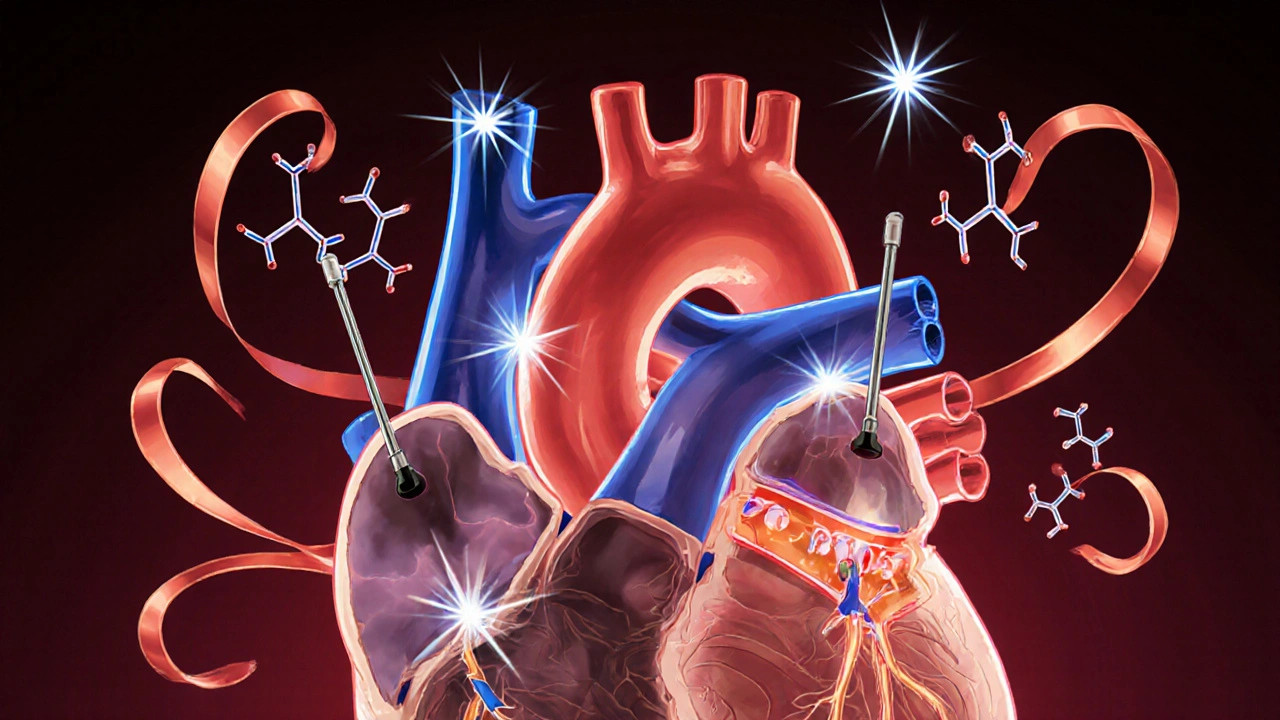CRT-Amiodarone QTc Risk Calculator
Calculate the risk of QTc prolongation exceeding 500 ms in patients receiving Cardiac Resynchronization Therapy (CRT) while taking amiodarone. The tool is based on clinical evidence from studies of CRT patients on amiodarone therapy.
Enter values above to see risk assessment
When managing heart‑failure patients, Amiodarone is a classIII anti‑arrhythmic drug that prolongs the cardiac action potential and is used to treat ventricular and supraventricular tachyarrhythmias. At the same time, Cardiac Resynchronization Therapy is a device‑based treatment that coordinates the timing of the left and right ventricles in patients with heart‑failure and electrical dyssynchrony. Putting these two together raises a lot of questions: does amiodarone help the device work better, or does it blunt the benefits? This guide walks you through the science, the clinical data, and the practical steps you need to decide whether to keep a patient on amiodarone after a CRT implant.
What Amiodarone Actually Does
Amiodarone blocks potassium channels (IKr), sodium channels, calcium channels and has non‑competitive alpha‑ and beta‑adrenergic blocking properties. The net effect is a prolonged QT interval and a slower heart rate. Because it works on multiple ion channels, it’s effective against a wide range of arrhythmias, from atrial fibrillation to ventricular tachycardia.
Key pharmacokinetic facts:
- Half‑life: 40-60days (can exceed 100days with chronic use)
- Oral bioavailability: 30-40%
- Steady‑state reached after 3-4months of therapy
- Metabolised in the liver by CYP3A4; many drug‑drug interactions
Because of its long half‑life, stopping amiodarone does not instantly reverse its effects. This lingering presence can be a double‑edged sword in CRT patients.
Cardiac Resynchronization Therapy in a Nutshell
Cardiac Resynchronization Therapy involves implanting a biventricular pacemaker that paces both the left and right ventricles simultaneously. The goal is to correct the delayed activation that often occurs in patients with left bundle‑branch block (LBBB) or other intraventricular conduction delays.
The therapy is indicated for patients with:
- Left ventricular ejection fraction (LVEF) ≤35%
- NYHA classII-IV symptoms despite optimal medical therapy
- QRS duration ≥130ms, especially with LBBB morphology
When these criteria are met, CRT can improve LVEF, reduce hospitalization, and extend survival.
Why the Interaction Matters
Both amiodarone and CRT target the same problem: abnormal electrical activation. Amiodarone slows conduction and can widen the QRS complex, while CRT tries to narrow it by synchronising ventricular activation. The interaction creates three possible scenarios:
- Synergistic benefit: Reducing premature ventricular beats may allow the biventricular device to maintain a more stable rhythm, improving the percentage of successful biventricular pacing.
- Neutral effect: The drug’s conduction‑slowing properties have no measurable impact on CRT outcomes, so clinicians can continue amiodarone without worry.
- Negative impact: Excessive QT prolongation can trigger torsades de pointes, forcing clinicians to turn off or re‑program the CRT device, thereby reducing its therapeutic gain.
Understanding which scenario applies to a given patient hinges on the underlying arrhythmia burden, baseline QRS width, and how tightly the device is programmed.
Clinical Evidence - What the Trials Show
Several prospective and retrospective studies have examined amiodarone use in CRT recipients. The most frequently cited data come from three sources:
- COMPANION sub‑analysis (2019): In 542 patients with CRT‑defibrillators, those on amiodarone had a 7% lower rate of all‑cause mortality, but the difference was not statistically significant after adjusting for comorbidities.
- MADIT‑CRT registry (2021): Amiodarone users showed a modest increase in biventricular pacing percentage (average 96% vs 93% in non‑users) and a 12% reduction in ventricular tachyarrhythmia episodes.
- European Heart Journal meta‑analysis (2023): Pooled data from six studies (1,356 patients) indicated that amiodarone reduced the incidence of atrial fibrillation recurrence by 18% without compromising CRT response rates.
Overall, the evidence points toward a neutral‑to‑positive effect, especially when the drug is used to control atrial fibrillation or frequent PVCs that would otherwise lower pacing effectiveness.

Practical Considerations - Dosing, Interactions, and Monitoring
When you decide to keep a patient on amiodarone after CRT implantation, follow these best‑practice steps:
- Loading phase: 800-1,200mg per day for 1-2weeks, then taper to 200mg daily. Many clinicians skip the loading phase in CRT patients to avoid early QT spikes.
- Maintenance dose: 100-200mg daily is usually enough for rhythm control; aim for the lowest effective dose to limit toxicity.
- Drug‑drug interactions: Watch for CYP3A4 inhibitors (e.g., ketoconazole, erythromycin) that raise amiodarone levels, and for drugs that also prolong QT (e.g., sotalol, certain macrolides).
- Laboratory monitoring: Baseline and quarterly thyroid (TSH), liver enzymes (ALT/AST), and pulmonary function tests. In CRT patients, also check device interrogation every 3months to ensure biventricular pacing >95%.
- ECG surveillance: Look for QTc >500ms; if observed, consider dose reduction or switching to a less potent anti‑arrhythmic.
Because amiodarone can cause bradycardia, coordinate with the electrophysiology team to set appropriate lower rate limits on the CRT pacemaker.
Choosing the Right Patients
Not every CRT candidate benefits from amiodarone. Ideal candidates share these traits:
- History of recurrent atrial fibrillation or frequent PVCs that jeopardise biventricular pacing.
- Unable to tolerate beta‑blockers or other rate‑control agents.
- No severe baseline QTc prolongation (preferably <460ms).
- Normal thyroid and liver function, or conditions that can be closely managed.
If a patient has mild LBBB without significant arrhythmia, the added drug risk usually outweighs any marginal benefit.
Risks Specific to the CRT Population
Amiodarone’s classic toxicities (pulmonary fibrosis, thyroid dysfunction, hepatic injury) are well documented, but a few nuances matter for CRT users:
- Device‑related oversensing: Amiodarone‑induced T‑wave changes can be misinterpreted as ventricular events, leading to inappropriate shocks in CRT‑defibrillators.
- Interaction with pacing thresholds: Some case series report a slight increase in capture thresholds after long‑term amiodarone, necessitating higher output settings.
- Reduced heart‑rate variability: Excessive bradycardia may limit the device’s ability to respond to physiologic demands, especially during exercise.
Close follow‑up-especially during the first six months-helps catch these issues before they compromise therapy.
Future Directions - Personalized Medicine Meets Device Therapy
Research is moving toward genotype‑guided anti‑arrhythmic selection. Polymorphisms in the CYP3A4 and ABCB1 genes influence amiodarone plasma levels, potentially predicting which CRT patients will experience toxicity. Ongoing trials (e.g., the EU‑CRT‑GENE study, expected results 2026) are testing whether pre‑implant genetic screening can refine drug choice.
Another promising area is adaptive CRT algorithms that automatically adjust pacing vectors when amiodarone‑induced QRS widening is detected. Early pilot data suggest a 4% increase in effective pacing without altering the drug regimen.
Bottom Line
For most patients who need rhythm control after CRT, amiodarone is a viable option-provided you respect its long half‑life, monitor for device‑specific interactions, and keep the dose as low as possible. The drug can actually improve the proportion of successful biventricular pacing by suppressing ectopy, which translates into better functional outcomes.
Always weigh the individual’s arrhythmia burden against the risk profile; when in doubt, a short‑term trial with careful device interrogation can reveal whether the synergy you hope for materialises.
| Drug | Class | Effect on QRS | Impact on Biventricular Pacing % | Key Toxicities |
|---|---|---|---|---|
| Amiodarone | III | Modest widening (10‑20ms) | ↑96% (studies show modest rise) | Pulmonary, thyroid, hepatic |
| Sotalol | III | Minor widening (≤5ms) | ↔93% (no clear benefit) | Pro‑arrhythmic, renal |
| Dronedarone | III | Minimal effect | ↔92% (neutral) | Hepatic, GI upset |
Frequently Asked Questions
Can amiodarone be started before CRT implantation?
Yes. Starting amiodarone early can stabilise rhythm, reduce PVC burden, and increase the likelihood that the device will achieve >95% biventricular pacing after implantation. However, a short loading phase should be avoided if the baseline QTc is already >460ms.
What is the safest amiodarone dose for a CRT patient?
Most experts aim for 100mg daily after the initial loading period. This dose maintains rhythm control for most atrial fibrillation or ventricular ectopy cases while minimising toxicity risk.
How often should the CRT device be interrogated when on amiodarone?
Every 3months is standard, but the first two interrogations after starting amiodarone should be at 4‑week intervals to catch any oversensing or pacing threshold changes early.
Does amiodarone interfere with the defibrillation function of CRT‑D devices?
Not directly. The drug can, however, provoke torsades de pointes if the QTc becomes extreme, which may trigger inappropriate shocks. Maintaining QTc <500ms mitigates this risk.
Are there any alternatives to amiodarone that work well with CRT?
Beta‑blockers remain first‑line for rate control, and catheter ablation of atrial fibrillation is increasingly used when drug therapy is contraindicated. In patients intolerant to amiodarone, sotalol or dronedarone can be tried, but the evidence for CRT synergy is weaker.








Posts Comments
James Falcone October 17, 2025 AT 18:34
Amiodarone and CRT? Just keep the drug if it stops the arrhythmia, no need to overthink.
Frank Diaz October 21, 2025 AT 05:54
The interplay of a multi‑channel blocker with a synchronization device is a microcosm of how we try to tame chaos with technology. One could argue that the very act of prolonging the action potential subtly reshapes the substrate that CRT seeks to correct. In practice, the drug smooths out ectopic beats, giving the biventricular pacemaker a cleaner canvas to paint on. Yet the prolonged QT is a reminder that our interventions are never without trade‑offs, and the specter of torsades looms like a cautionary tale. Ultimately, the decision rests on weighing the marginal benefit of rhythm control against the incremental risk of electrical instability.
Mary Davies October 24, 2025 AT 17:14
Picture a heart attempting a symphony; amiodarone is the conductor that slows the tempo while CRT tries to align the sections. When the tempo is too slow, the violins fall out of sync, but the rhythm section still plays on. In patients with frequent PVCs, damping those rogue notes lets the device maintain near‑perfect synchrony. Conversely, an overly prolonged QT can turn the performance into a discordant nightmare. The art lies in finding that sweet spot where the drug quiets the chaos without muting the beat.
Valerie Vanderghote October 28, 2025 AT 04:34
Let me walk you through the cascade of effects that a seasoned clinician observes when juggling amiodarone with a CRT system. First, the drug’s blockade of potassium channels drags the repolarization phase, extending the QT interval; this is a double‑edged sword that can be therapeutic or perilous.
Second, the prolonged refractory period reduces the propensity for premature ventricular contractions, which in turn lifts the percentage of biventricular pacing-a key metric of CRT success.
Third, the very same QT elongation raises the specter of torsades de pointes, a rhythm that can wreak havoc on a device calibrated for regular rhythms.
Fourth, the pharmacokinetic inertia of amiodarone, with its 40‑to‑60‑day half‑life, means that any adjustment echoes through weeks or months, complicating the titration of device parameters.
Fifth, drug‑drug interactions via CYP3A4 can spike serum levels, especially when patients are on statins or certain antibiotics, demanding vigilant monitoring.
Sixth, clinicians must reconcile the paradox of a drug that slows heart rate with a device that may be set to a higher lower rate limit, lest bradycardia triggers unnecessary pacing.
Seventh, the meta‑analysis from 2023 suggests a neutral‑to‑positive trend, but the confidence intervals are wide, indicating that individual patient characteristics drive outcomes more than the drug itself.
Eighth, real‑world registries, like the MADIT‑CRT cohort, show a modest uplift in pacing percentages, but the absolute clinical benefit remains modest.
Ninth, the recommended maintenance dose of 100 mg daily after loading provides enough anti‑arrhythmic heft without the toxic baggage of higher doses.
Tenth, quarterly checks of thyroid, liver, and pulmonary function are non‑negotiable; neglecting them can turn a well‑tuned device into a ticking time bomb.
Eleventh, device interrogation every three months-as a rule-should be accelerated to four‑week intervals during the first two post‑initiation visits to capture any sudden shifts in sensing or threshold.
Twelfth, patient education is paramount; they must report symptoms of dizziness or visual changes, which could herald emerging toxicity.
Thirteenth, the decision matrix should factor in baseline QTc; if it hovers above 460 ms, a conservative loading strategy is advisable.
Fourteenth, the presence of atrial fibrillation often tips the scales in favor of amiodarone, given its superior efficacy in maintaining sinus rhythm compared with rate‑control agents.
Fifteenth, and perhaps most importantly, a multidisciplinary discussion involving electrophysiology, heart failure, and pharmacy teams ensures that the nuanced interplay of drug and device is harmonized for each unique patient.
Emily (Emma) Majerus October 31, 2025 AT 15:54
Sounds like a solid plan – keep the dose low and watch those labs.
Virginia Dominguez Gonzales November 4, 2025 AT 03:14
Exactly, the low‑dose strategy gives you rhythm control without the drama of severe side‑effects. Plus, those quarterly checks aren’t just paperwork; they catch problems early before they snowball.
Carissa Padilha November 7, 2025 AT 14:34
Ever wonder why the big pharma pushes amiodarone so hard? They love the long half‑life – it keeps patients hooked for months, ensuring a steady stream of prescriptions. Meanwhile, the subtle QT prolongation they brag about in trials is a perfect cover for occasional sudden deaths that get swept under the rug. The CRT industry benefits too, because a device that looks like it works better on a drug‑laden patient sells more units. It's a tangled web of profit and risk, and we’re the ones left to sort it out.
Richard O'Callaghan November 11, 2025 AT 01:54
i see youre point but think about the data ---- the studyspublish show benefit
the leffects of amiodarone are not that big as some claim
Winston Bar November 14, 2025 AT 13:14
Another day, another drug that promises miracles but delivers side‑effects.
Miriam Rahel November 18, 2025 AT 00:34
While the anecdotal enthusiasm is understandable, a rigorous appraisal of the literature reveals that the purported synergistic effect of amiodarone with CRT lacks robust statistical significance. The COMPANION sub‑analysis, for instance, fails to demonstrate a mortality benefit after adjustment for confounders. Moreover, the modest increase in biventricular pacing percentages does not translate into meaningful clinical endpoints in most trials. Consequently, a prudent clinician should reserve amiodarone for patients with clear arrhythmic indications rather than employing it empirically to augment device performance.
Samantha Oldrid November 21, 2025 AT 11:54
Oh sure, because the only way to trust science is to read a five‑page meta‑analysis while ignoring bedside reality.
Write a comment